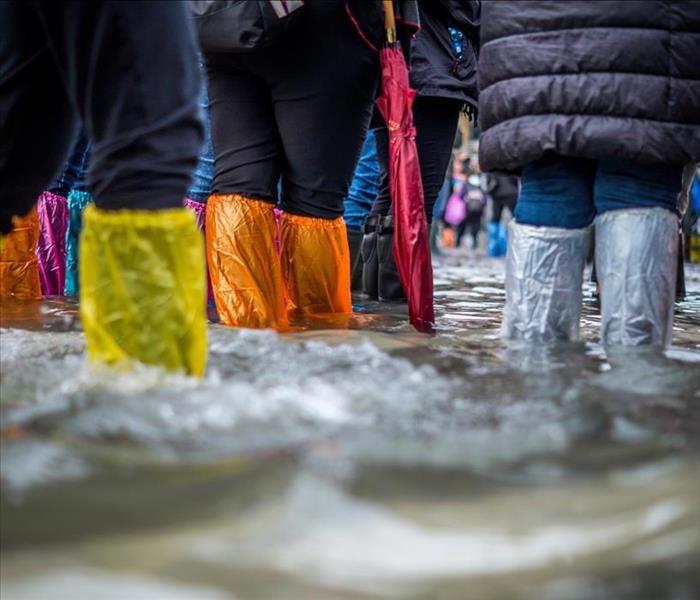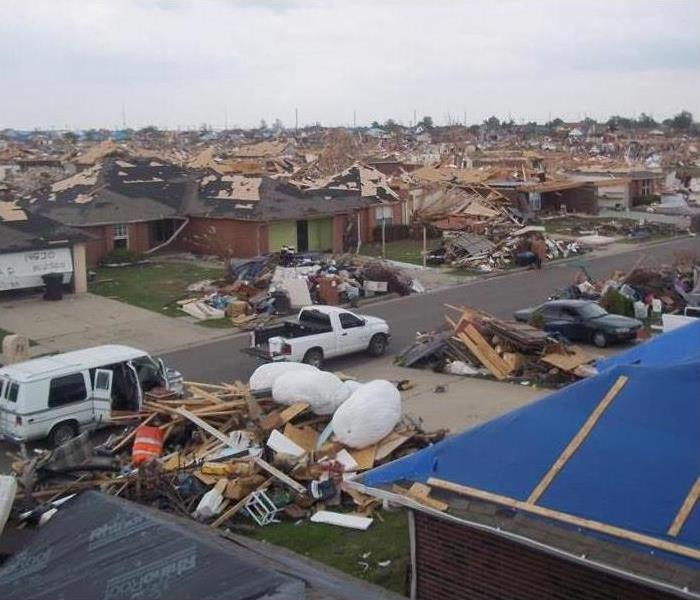Recent Storm Damage Posts
ELSA HAS VISITED THE ARKLATEX!
11/11/2024 (Permalink)
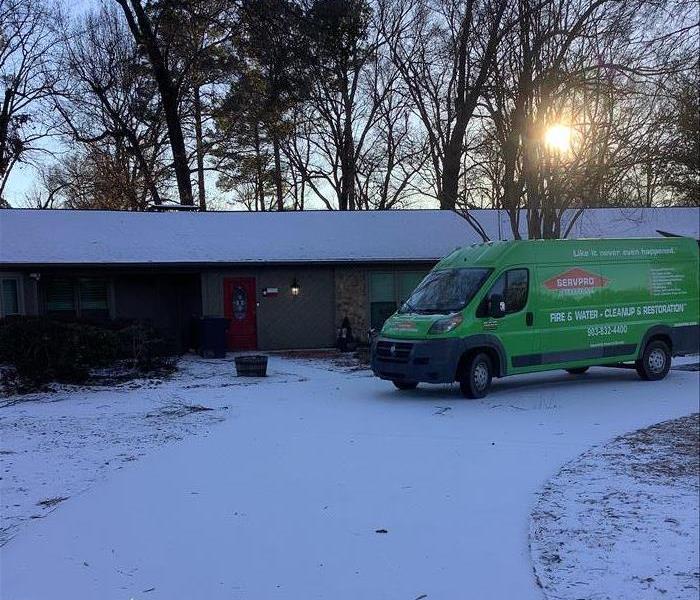 Our SERVPRO® van likes to make snow angels too!
Our SERVPRO® van likes to make snow angels too!
During the colder weather, rain may visit and leave its friend – ICE! Fortunately, SERVPRO of Texarkana is equipped to handle many storm situations. Much like any area in the path of Winter rain resulting in a freeze, the ARKLATEX area freezes over and Water Damage wreaks havoc on properties in the metroplex.
BASIC SAFETY FIRST!
- Rock salt or more environmentally safe products to melt ice on walkways
- Sand to improve traction
- Snow shovels and other snow removal equipment
- Sufficient heating fuel, like dry, seasoned wood for your fireplace or wood-burning stove
- Adequate clothing and blankets to keep you warm
MAKE A PLAN!
- Make a family emergency plan — Your family may not be together when disaster strikes, so it is important to know how you will contact one another, how you will get back together and what you will do in case of an emergency
- Listen to National Weather Service and be alert to changing weather conditions
ENSURE EVERYONES SAFETY!
- Minimize travel, but keep a disaster supplies kit in your vehicle
- Bring pets/companion animals inside during winter weather
- Move other animals or livestock to sheltered areas with non-frozen drinking water
AFTER THE FREEZE – HANDLING WATER DAMAGE!
After the temperatures rise once again, the ice melts, the pipes thaw and bring Water Damage. SERVPRO of Texarkana is ready to assist the community with highly trained technicians. Our technicians will be dispatched to your property equipped with air movers and dehumidifiers, two of our main friends that help assist with drying out any affected property after a Water Loss.
CONTACT US!
If you fall victim to a disaster within your home or business, let SERVPRO of Texarkana help! Give us a call to schedule our PRO's for services or visit our website for more information on the many services offered by our company.
Office: 903-832-4400
Website: SERVPROtexarkana.com
CAUGHT IN A TEXAS TORNADO!
11/7/2023 (Permalink)
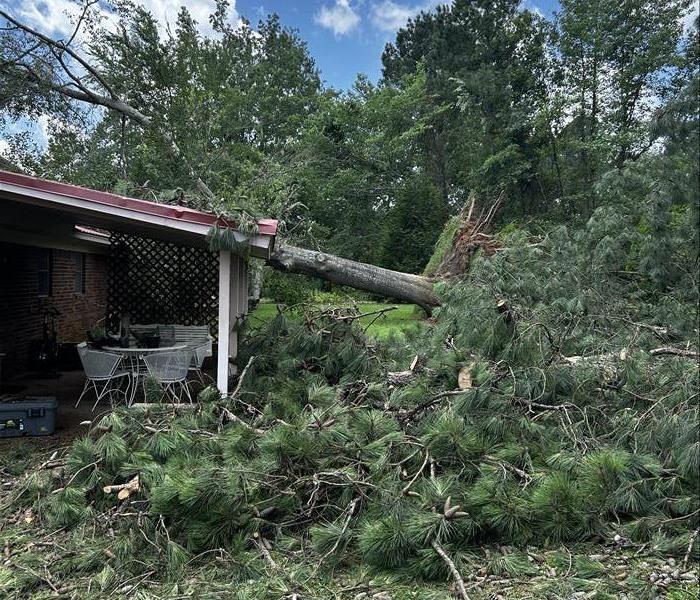 TIMBER! Storm causes tree to fall onto home.
TIMBER! Storm causes tree to fall onto home.
SEVERE WEATHER TIPS
Since SERVPRO partners with the American Red Cross we love sharing their tips from time to time.
TORNADOES
Tornadoes can strike without warning and destroy a community in seconds. Before a tornado warning is issued for your area, here are some things you should do:
- Know your community’s warning system.
- Pick a place where family members can gather if a tornado is headed your way. It could be your basement, a center hallway, bathroom, or closet on the lowest floor. Keep this place uncluttered.
- If you are in a high-rise building and don’t have enough time to safely get to the lowest floor, pick a place in a hallway in the center of the building.
- Remove damaged limbs from trees.
- Move or secure lawn furniture, trash cans, hanging plants or anything else that can be picked up by the wind and become a hazard.
THUNDERSTORM SAFETY STEPS
Thunderstorms injure an average of 300 people every year, and cause about 80 fatalities. Here are the top thunderstorm safety steps you should follow:
- If you can hear thunder, you are close enough to the storm to be struck by lightning. Go to safe shelter immediately.
- As the storm approaches, take shelter in a building.
- If you are driving, pull off the roadway and park. Stay in the car with the windows closed and turn on the emergency flashers. Avoid touching metal or other surfaces that conduct electricity in and outside of the vehicle.
- If you are inside, unplug appliances and avoid using the telephone or any electrical appliances. Avoid taking a bath or shower, or running water for any other purpose.
- If you are caught outside and cannot reach a safe building, avoid high ground, water, tall, isolated trees and metal objects such as fences or bleachers. Picnic shelters, dugouts and sheds are not safe.
FLOODING
Heavy rains could fill rivers and streams, bringing flooding to the area. If your neighborhood is threatened with the possibility of flooding, here are some things you should do:
- Be prepared to evacuate at a moment’s notice. When a flood or flash flood warning is issued for your area, head for higher ground and stay there.
- Stay away from floodwaters.
- If you come upon a flooded road while driving, turn around and go another way. If you are caught on a flooded road and waters are rising rapidly around you, get out of the car quickly and move to higher ground. Most cars can be swept away by less than two feet of moving water.
- Keep children out of the water.
- Be especially cautious at night when it is harder to recognize flood danger.
Check out www.redcross.org for more information!
When Storms or Floods Hit
11/1/2022 (Permalink)
SERVPRO of Texarkana specializes in storm and flood damage restoration. Our crews are highly trained and we use specialized equipment to restore your property to its pre-storm condition.
Faster Response
Since we are locally owned and operated, we are able to respond quicker with the right resources, which is extremely important. A fast response lessens the damage, limits further damage, and reduces the restoration cost.
Resources to Handle Floods and Storms
When storms hit the Texarkana area, we can scale our resources to handle a large storm or flooding disaster. We can access equipment and personnel from a network of 1,650 Franchises across the country and elite Disaster Recovery Teams that are strategically located throughout the United States.
Have Storm or Flood Damage? Call Us Today 903-832-4400
Storm Damage Can be Extensive
9/1/2022 (Permalink)
Fixing Your Home After a Storm is Easier With Professional Help
If your home has experienced a storm that was powerful enough to cause gusting winds, you should inspect your home's exterior for missing siding, corner pieces, and shingles. Shingles that are loose can pose hazards later, even in dry, sunny weather, if they fall to the ground. Shingles are very heavy and can cut someone. If a nail is still attached to the shingle, this can pose additional risks if someone steps on one that has fallen point-side upward.
While Texarkana homes are beautiful, this does not stop them from being subject to storm damage. Damage from storms can range from broken tree limbs scratching siding and breaking windows to entire trees falling on your home's or garage's roof. Carports are also damaged quite often and easily by strong winds, especially when heavy items are pushed into their support structures. Hail can also create damage to exterior furnishings such as lawn chairs and tables.
Restoration is not Easy, but it is Possible
If you have damage from a storm, it is imperative to begin restorative work and repairs immediately. Dented items such as metal table tops and outdoor grill covers can suffer from additional damage if left unrepaired. Painting such surface will keep rust and corrosion to a minimum.
We at SERVPRO can help you eliminate the damage from the storm, and recreate your personal paradise. Damage to your home's structure is also possible. Windows and doors that have been affected by the storm can be repaired and rehung. Appearance is as important as functionality, and we strive to make your disaster a distant memory as we work to make it "Like it never even happened." both inside and out.
Professional Crews are Available 24/7 to Begin and Complete the Work Needed
Call us at SERVPRO of Texarkana at (903) 832-4400 so we can inspect and assess the work needed to bring your home back to normal again. Our professionals are IICRC trained and certified in both large and small damaged areas, and collaborate to decrease the amount of time required to complete all needed repairs.
How To Protect Your Augusta Home Against Rainwater
8/12/2022 (Permalink)
Waterproof the Exterior Of Your House
At SERVPRO of Texarkana we understand that the aftermath of water damage is one of the most stressful things that a homeowner can experience. It can be a very big and expensive problem if not treated properly and in a timely fashion. The best way to deal with water damage is to stop it before it starts. The exterior of your house is the first line of defense against water damage.
Maintain Your Roof
The roof’s primary purpose is to keep water out of your shelter. Not making sure your roof is taken care of can lead to a host of problems- the worst being extensive water damage that could permanently damage the structure of your home. Most roofs have a 20-30 year lifespan, however climate, weather conditions and even trees could cause damage to your shingles and create a leak. It’s best to periodically inspect your roof for damaged or missing shingles. Replacing compromised shingles is a quick and inexpensive fix that can extend the shelf life of your roof.
Add Sealant to Your Windows And Doors
Entryways to your house are common sites that promote water damage and leakage into the home. Water can seep through the cracks around your windows and doors if they aren’t properly secured. Instead of waiting on the leak to happen, go ahead and make sure these areas are weather-stripped and have fresh sealing. You can easily repair large cracks with insulating foam sealant or dd some caulking where the window meets the siding.
Make Sure Your Home’s Exterior Is Protected
If you’re spotting some signs of water damage on your interior walls but aren’t seeing a source of leakage, it’s highly likely that water is entering through holes in your exterior walls. If your siding or exterior paint aren’t well managed water could seep through inside your home. Common sidings such as stucco, aluminum siding or wood siding has to be painted in order to protect the home against water properly. Paint is more than a pretty feature, it seals your siding and protects your home from weather related issues.
Making sure your gutters are properly functioning and aren’t clogged is also a huge part of protecting your home from water damage. If your gutters are full of leaves, sticks and pine needles or not angled correctly, water will be redirected down the side of your house and collect at the base of your home. Start by clearing out all the junk in your gutters and ensuring that they are not damaged.
Correctly functioning gutters should send water through the downspout, which shoots water away from your home. When checking gutters make sure that your downspout extends far enough at the bottom to redirect the water drainage to a safe distance away from the base of your home.
Pro Tip: Downspouts should direct water at least three feet from the exterior walls of your home.
Avoiding Storm Damages for Your Home
8/9/2022 (Permalink)
Ten Easy Steps to Protect Your Home from Storm Damage
- Replace missing or damaged shingles.
When a shingle is damaged it is much more cost efficient to replace it immediately. As waiting until the damages are so severe that you must replace an entire section of roof, or the whole roof.
- Repair or replace loose siding.
The same rule of thumb applies here with siding as it does roofs.
- Ensure proper sealing of doors and windows
If your home isn't properly weather-proof, seeping water can pose a huge threat.
- Ensure water flow is directed away from your home.
Make sure all water is flowing away from your home and towards a ditch, drain, or other proper retention area.
- Keep your gutters clear.
Clearing gutters for free flow of water and proper downspouts are helpful in extending the life of the foundation of your home. Water damage by flooding is one of the quickest ways to devalue your home. Making sure the gutters are clear is the first line of defense in avoiding water damage.
- Check for loose or damaged fence posts.
Wind can be an unexpected danger. Posts that are not nailed down could be a liability. Checking your fence posts is typically easy, Tip: Walk to each post and give a firm shake to each one to check for any needed repairs.
- Regularly trim your trees.
Tree limbs can damage your home, and surrounding neighbor’s homes. Keeping trees trimmed and well managed is an excellent way to protect your roof and windows.
- Keep your sump pump in working order.
Spring often brings a lot of excess rain, so before rain season starts, check that your sump pump is in proper working order. If you want to feel secure, having a backup sump pump is a guaranteed way to avoid flooding in your home.
- Walk around your property.
If you know a storm is coming, take some time to check through basic maintenance steps to protect your home. Identify any items around your property that could pose as projectiles. These items could include lawn furniture, tools, or yard debris. Avoid damage by moving potential threats to a garage or shed to be safely stored.
- Keep a generator on hand.
A bad storm could potentially knock out power to your home for hours or even days. Having a generator on standby could save you time and money ensuring you don’t have to throw away refrigerated foods or create water leaks from unpowered appliances.
Storm season brings a lot of uncertainty, but that doesn’t mean there’s nothing you can do about it. If a disaster does occur, feel safe knowing you can call SERVPRO of Texarkana at 903-832-4400.
Clouds
7/25/2022 (Permalink)
Did you know there are different kinds of clouds that can deliver rain and snow, as well as thunderheads that can produce lightning and heavy precipitation?
Rain/Snow
Stratus clouds are low to mid-level clouds that develop into horizontal, flat formations, and stratus clouds can appear dark and dense or white and puffy. Storm fronts are often preceded or followed by stratus cloud formations carrying precipitation as rain or snow. Because temperatures are warmer closer to Earth and cooler higher up in the atmosphere, low-hanging stratus clouds generally bring rain while higher stratus clouds are associated with snow.
Thunderheads
Cumulus clouds are dense and puffy vertical cloud formations that extend as high as 15,000 meters (50,000 feet) into the atmosphere. Although cumulus clouds are common on sunny, fair-weather days, they earn the moniker of thunderheads because of their tendency to produce thunderstorms. A cumulus cloud becomes a cumulonimbus cloud capable of severe thunderstorms when sufficient heat, updraft and moisture combine in the cloud to produce lightning, thunder and heavy rains.
The next time you see cloud formations in the sky, see if you can figure out what kind it is.
Wind-Damaged Home in Texarkana?
6/15/2022 (Permalink)
Do you know that our SERVPRO team in Texarkana responds to storm damage emergencies 24-hours a day? Last month, strong winds and severe weather pummeled the area.
High Wind Warning: Take Action! Sustained, strong winds with even stronger gusts are happening. Seek shelter. If you are driving, keep both hands on the wheel.
High Wind Watch: Be Prepared! Sustained, strong winds are possible. Secure loose items and adjust plans as necessary so you’re not caught outside.
Wind Advisory: Take Action: Strong winds are occurring but are not so strong to warrant a High Wind Warning. Objects outdoors should be secured, and caution should be taken if driving.
Severe Thunderstorm Warning: Take Action! A thunderstorm is happening or is imminent in the warning area. Severe thunderstorms have 58 miles per hour wind gusts and/or hail one inch or larger. Seek shelter inside a sturdy building.
Preparing for High Winds
- Remove any dead trees or overhanging branches near structures
- Remove loose objects outdoors, on patios, roofs, or balconies that could blow away
- Shutter windows securely and brace outside doors
- Bring in unsecured objects from outside and secure things that could blow away and cause damage or injury
Call Us Today!
When your home or business needs storm damage restoration services, our local team in Texarkana will restore the damage, “Like it never even happened.” Call us today at 903-832-4400.
Franchises are independently owned and operated.
Flooded House Due to A Storm?
5/31/2022 (Permalink)
Step 1 - Emergency Contact
Step 2 - Inspection and Water Damage Assessment
We inspect and test to determine the extent of damage and how far the moisture has traveled to ensure proper and complete restoration.
Step 3 - Water Removal / Water Extraction
We use powerful pumps and vacuum units to remove hundreds or thousands of gallons from your property quickly. This helps prevent secondary water damage and mold growth.
Step 4 - Drying and Dehumidification
Our Professionals will use room measurements, temperature, and relative humidity to determine the optimal number of air movers and dehumidifiers needed to dry your home or business.
Step 5 - Cleaning and Sanitizing
We clean all of the restorable items and structures damaged by the water. Our professionals are trained to provide sanitizing treatments and to remove odors and deodorize your property.
Step 6 - Restoration
Restoration may involve minor repairs, such as replacing drywall and installing new carpet or may entail major repairs, such as the reconstruction of various areas or rooms in a home or business.
Call Us!
When your home or commercial business has water damage from a storm and needs emergency restoration services, our local team in Texarkana is Here to Help. Call us today at 903-832-4400.
Franchises are independently owned and operated.
What can professionals do to help your home?
2/28/2022 (Permalink)
Floods are common enough to the Texarkana area to warrant a preparation plan. Homeowners should know what to do in case of these emergencies, and often that means whom you can call to help when contending with the damage that these circumstances can cause. There are multiple strategies for restoring and cleaning up after a flood loss in your home, and our SERVPRO team can help.
How Does SERVPRO Address Standing Floodwater?
One of the immediate obstacles to flood damage in Texarkana homes is standing water in the property's lower levels. Because traditional extraction devices might not be useful in these situations, namely, due to solids and debris, more powerful units must get used instead. Some of these options include:
- Self-priming trash pumps
- Truck-mount extractors
- Wet vacuums
Despite how overwhelming flood losses can be for area homes, our SERVPRO of Texarkana's team can help with a fast and reliable response. Give us a call today at (903) 832-4400.
Protecting Your Texarkana Home
2/28/2022 (Permalink)
Homeowners in the Texarkana area, need to pay close attention to events within and outside their homes to identify risks and be prepared to deal with them. Although average temperatures are generally pleasant and make for the enjoyment of outdoor activities, storms can cause significant damage. The same can be said for accidents within the home, such as kitchen fires and ruptured pipes. Those, too, may leave homeowners needing professional restoration services.
The crew at SERVPRO of Texarkana is certified by the Institute of Inspection, Cleaning and Restoration (IICRC), the certifying body in our industry that attests to our expertise level. Our experience in dealing with the aftermath of a storm or a fire makes itself evident from the minute we walk through your door. When you call our 24/7 hotline, you should expect-
- Utmost attention to safety, including the use of personal protective equipment and establishment of physical barriers throughout your home as needed
- Use of industrial-grade equipment tailored to the needs of your situation
- Complete documentation of our process
- Coordination with other relevant parties, including insurance and subcontractors
In the winter months, in particular, Texarkana residents may run the risk of storm water entering their homes. Continuous copious rain can cause a rise in water levels and open houses to the possibility of flooding regardless of our efforts to prevent it. As some roads become unpassable and parts of the city come to a halt, homeowners find themselves needing professional help.
What Can I Do to Avoid Water Damage in the Future?
2/14/2022 (Permalink)
While it is impossible to avoid a natural disaster, you can be proactive about protecting your property. SERVPRO has enough experience to tell our customers some of the things to do to prepare for the future:
- Know the flood risk for your area
- Put together a flood plan in advance
- Make sure that you always have an emergency kit readily available
- Have essential documents stored in a safe and dry place
- Always test out your sump pump and back-up generator periodically
- Choose a restoration team before the disaster even happens
When you have our number handy, you will have access to emergency flood damage services 24 hours a day, seven days a week. We know that a significant storm and flooding event can be overwhelming and devastating. Whenever you have flooding in your home, simply give us a call. We will:
- Remove and dispose of any materials damaged beyond repair
- Dry out any contents or provide pack-out services for off-site cleaning
- Monitor the entire drying process, ensuring everything is dry in a timely manner
SERVPRO of Texarkana has the resources and manpower to tackle any storm or disaster that leaves you with flood damage. Call us at (903) 832-4400, and we can send out a team as soon as possible to get started on an assessment.
Effectively Treating Flood Damage In Home
1/20/2022 (Permalink)
Floods cause significant damage throughout your home, making it necessary to secure professional help to recover. Entering your home after a flood can be emotional; you should leave your family safe and secure in temporary housing while letting trained personnel evaluate your situation.
When you experience flood damage in your home, the first thing you should do is get your family to safety. After that, contact your insurance agent and any family members to let them know you are okay. Once secure, communicate with the professionals necessary to get you the help you need.
It is important to understand that your home can contain contaminated mud and debris. By contacting a company like SERVPRO, you get the help you need to remove this debris while also cleaning and disinfecting various surfaces found in your home. It would be best if you secured any furniture and other household items before recovery can begin.
Flood Damage Clean Up
SERVPRO technicians make quick work of removing saturated, unrestorable materials from your home. All wallboard, plaster, or paneling up to 2-feet above any flood level requires removal before an efficient drying procedure begins. The structural materials, exposed wiring, and plumbing require special handling. Saturated insulation needs replacing, along with carpeting and pads in most situations.
SERVPRO technicians understand how to avoid hazards that often accompany floods, turning off electrical systems, checking appliances and your HVAC system as a part of our initial inspection. Vinyl and tile flooring may require removal to properly dry the subfloor, while wood floors can dry gradually over time.
Leaking Roof from Storms
There may be roof damage from defective flashing, clogged downspouts or eaves, cracks, and deterioration caused by missing shingles. A complete inspection reveals problems like this and provides you with the recommendations required to save your home. We can help you avoid future damage by installing additional draining, backflow valves, or sump pumps.
Contact SERVPRO of Texarkana for access to IICRC certified technicians 24-7. Leave your troubles to us; remain safe and sound. (903) 832-4400.
Thunderstorm Preparedness
8/10/2021 (Permalink)
Thunderstorms are beautiful, but they can also be dangerous. They can cause severe damage to your home and property. Thunderstorms include lightning and can:
- Include winds over 50 MPH
- Create hail
- Cause flash floods
- Cause tornadoes
In most places, a thunderstorm can happen at any time of the year and at any time of the day.
SERVPRO of Texarkana knows you cannot prevent a thunderstorm, but you can prepare:
- Know the risk for thunderstorms in your area
- Sign up for your community’s warning system
- Cut down or trim trees that may fall on your home or office
- Install surge protectors, lightning rods, or a lightning protection system
SERVPRO of Texarkana repeats the warning, “When thunder roars, go indoors”. You don’t have to wait for the thunder. If there is a thunderstorm warning, go inside. Once there:
- Unplug appliances
- Do not use landline phones in office or home
- Pay attention to alerts and warnings
If you can’t get inside a building:
- If you are swimming or in a boat, get to land immediately. Find shelter
- If you are in a car, don’t touch anything metal
- “Turn around. Don’t Drown. '' Avoid flooded roads. 6 inches of moving water can knock you down. One foot of moving water can sweep away your car.
A lightning strike during a thunderstorm can leave a wake of destruction in its path. This can range from minor electrical issues to fire damage. Lightning is also a major cause of injury or death from weather-related dangers. Most people survive being hit by lightning, but they often have long-term problems.
SERVPRO of Texarkana is independently owned and operated.
Tornado Need to Know
5/28/2021 (Permalink)
Tornadoes are known to cause widespread damage throughout the United States, especially in the Southern Plains and SouthEast. But how much do we truly know about these destructive entities that tear through our homes and businesses?
Here are a couple of quick facts about tornadoes:
The average tornado travels Southwest to Northeast but have been known to move in any direction.
Tornadoes are most likely to occur between 3pm and 9pm but can occur at any time.
Dr. T. Theodore Fujita devised the F0-F5 Scale for tornadoes in 1971.
In 2006 the National Weather Service unveiled the Enhanced Fujita Scale (EF Scale).
A tornado normally appears transparent until it picks dust and mud from the ground.
The USA averages around 1,200 tornadoes every year, more than any other country.
In the southern hemisphere tornadoes usually rotate in a clockwise direction. In the northern hemisphere tornadoes usually rotate in a counterclockwise direction.
Signs of Danger
We encourage everyone to be weather aware. Have a family plan in the event of a tornado warning. Know where your safe areas are wherever you are.
Be prepared for power outages from storms in Texarkana
3/9/2021 (Permalink)
Managing Without Power in Texarkana
SERVPRO of Texarkana has seen storm damage lead to power outages.
A power outage can:
- Disrupt communication
- Make transportation difficult
- Shut down water pipes
- Close businesses, grocery stores, gas stations, banks, ATMS, other services
- Lead to food spoilage
- Lead to contaminated water
- Disable medical devices
During a power outage in Texarkana, be sure to:
- Keep freezer & refrigerator doors closed. It will reduce the chance of food spoilage
- User generators only outdoors and away from windows
- Disconnect appliances/electronics. Power surges can destroy equipment
- Have already set up a plan to refrigerate medicines
- For people who use power wheelchairs, have a backup battery. You may also need a manual chair
- The local power company should already know that someone in your home relies on medical devices
- Do not use a gas stove or oven to heat your home or business
- If travel is safe, go to another location for proper heating or cooling
- Check on your neighbors.
Flood Facts
2/19/2021 (Permalink)
There is always potential for flood damage no matter where you live. According to the American Red Cross floods cause more damage in the United States every year than any other weather-related disaster. The American Red Cross offers these flood safety tips:
-Stay away from floodwaters. If you come up on a flowing stream where water is above your ankles, stop, turn around and go another way. Six inches of swiftly moving water can sweep you off of your feet.
-If you approach a flooded road while driving, turn around and go another way. If you are caught on a flooded road and waters are riding rapidly around you, get out of the car quickly and move to higher ground. Most cars can be swept away by less than two feet of moving water.
-Keep children out of the water. They are curious and often lack judgment about running water or contaminated water.
If a flood occurs and affects you, call SERVPRO of Texarkana. Even minor floods have potential to cause major damage. We are faster to ANY size disaster. Let us help you get your life back in order.
Natural Disasters
2/11/2021 (Permalink)
Every summer, the U.S. goes through an “active weather” season. The middle of spring through summer is a prime time for hurricanes, tornadoes, floods, thunder storms, and fires. Here at SERVPRO, we’ve already begun to see the impact of the severe weather. We have already experienced a large amount of rain. Luckily, our SERVPRO team is here for any natural disaster. We respond to water, wind and fire damage! Here are some weather events to look out for during the spring and summer months:
- Hurricanes–Hurricanes, with the accompanying wind, water, and flood, cause a lot of destruction in areas where they hit. When hurricanes gather strength, buildings, trees, and water infrastructures are commonly destroyed. The storms can also knock down power lines, posing a risk of electrocution.
- Tornadoes– Tornadoes are characterized by whirling winds and debris and can endanger life and property. They are common from spring until the middle of summer but can occur any time of the year.
- Floods– Floods are becoming more common in the U.S., with flash floods as the top weather-related killer. A few inches of water could bring extensive damage to homes and buildings. Heavy rains, levee breaches, and tsunamis cause floods. Many floods occur in areas that cannot absorb rainwater.
- Fires– The heat of the summer and the years of drought experienced in many parts of the country can precipitate massive forest fires that, in many instances, affect dwellings. Spontaneous combustion, volcanic eruption, and faulty electrical wires are other common causes of fires.
Call SERVPRO if you are ever in need after a natural disaster!
Water Damage Big or Small
1/20/2021 (Permalink)
Faster To Any Size Disaster
Flooding and water damage is very invasive. Water quickly spreads throughout your home and gets absorbed into floors, walls, furniture, and more. SERVPRO of Texarkana arrives quickly and starts the water extraction process almost immediately. This immediate response helps to minimize the damage and the cleaning and restoration costs.
Water emergencies don’t wait for regular business hours and neither do we. SERVPRO of Texarkana provides emergency cleaning and restoration services 24 hours a day, 7 days a week—including all holidays.
Timeline for Water Damages
Within a few Minutes
- Furniture finishes may bleed, causing permanent staining on carpets.
- Water quickly spreads throughout your property, saturating everything in its path.
- Photographs, books, and other paper goods start to swell and warp.
- Water is absorbed into walls, floors, upholstery, and belongings.
1 – 24 Hours:
- Drywall begins to swell and break down.
- Metal surfaces begin to tarnish.
- Furniture begins to swell and crack.
- Dyes and inks from cloth and paper goods spread and stain.
- A musty odor appears.
48 Hours - 1 Week:
- Mold and mildew may grow and spread.
- Serious biohazard contamination is possible.
- Doors, windows, and studs swell and warp.
- Paint begins to blister.
- Metal begins to rust and corrode.
- Furniture warps and shows signs of mold.
- Wood flooring swells and warps.
Over 1 Week or More:
- Structural safety, mold growth, and biohazard contaminants pose serious risks to occupants.
- Restoration time and cost increase dramatically; replacing contaminated materials and structural rebuilding may be extensive.
Need Emergency Service? Call Us 24/7 – SERVPRO of Texarkana 903-832-4400
About SERVPRO of Texarkana
SERVPRO of Texarkana's staff is highly trained in property damage restoration. From initial and ongoing training at SERVPRO’s corporate training facility to regular IICRC-industry certification, rest assured our staff is equipped with the knowledge to restore your property.
Safety Tips for Lightning
1/18/2021 (Permalink)
Lightning is one of the leading causes of weather-related fatalities. Some factors can put you at greater risk for being struck. Here are a few safety tips for when it is lightning.
Be aware. If the weather forecast calls for thunderstorms, postpone your trip or activity, or make sure adequate safe shelter is available. Be sure to check the forecast before participating in outdoor activities.
Avoid electronic equipment. Lightning can travel through electrical systems, radio, and television reception systems, and any metal wires or bars in concrete walls or flooring. Do not use computers, laptops, game systems, washers, dryers, stoves, or anything connected to an electrical outlet. Equip homes and offices with whole-house surge protectors to protect appliances.
Stay indoors. Remember the phrase, “When thunder roars, go indoors.” Find a safe, enclosed shelter when you hear thunder. Like homes, offices, shopping centers, and hard-top vehicles with the windows rolled up.
Avoid water. Do not bathe, shower, wash dishes, or have any other contact with water during a thunderstorm because lightning can travel through a building’s plumbing.
Avoid windows, doors, porches, and concrete. Lightning can travel through any metal wires or bars in concrete walls or flooring. Do not lie on concrete floors and avoid leaning on concrete walls.
Storm Restoration
1/8/2021 (Permalink)
Has your home recently suffered hurricane damage? Wind damage? Are you facing a roof repair? If you're facing storm restoration, you aren't alone. Many homeowners find they have to repair their homes following a difficult storm. Before you begin to deal with storm restoration, here's what you need to know.
Don't do it alone
Whether you're dealing with hurricane damage, wind damage, or hail damage, don't try to repair on your own. Flooding or ground water can seem like an easy thing to fix, but the reality is that you should always contact a home restoration professional to help. Wind damage, and hail damage can be devastating to a home, but home restoration is possible with storm remediation.
If you notice roof damage, a roof leak, flooding, hail damage, or frozen pipes, reach out to SERVPRO of Texarkana experts immediately. Never wait to see if the frozen pipes or roof leak will get worse. The sooner you seek home restoration, the better off your home will be.
Help is waiting 903-832-4400
Being Storm Calm
10/22/2020 (Permalink)
Storm damage can happen at any time of day and can cause an enormous amount of harm to your home or business. Heavy rains and powerful winds can cause roof damage and broken trees.
Diseases become more likely in the event of a storm disaster. The Norovirus and West Nile Virus along with other bacterial infections become a greater possibility because the flood water can infect anything it touches.
SERVPRO of Texarkana always make sure that we are prepared when we know a storm is coming to town. We have meetings that pay special attention to 'what if' situations that could occur. Our crews make sure that the trucks and vans are loaded with tools, containment materials, disinfectant chemicals and any other drying equipment we may need.
Hurricanes
10/6/2020 (Permalink)
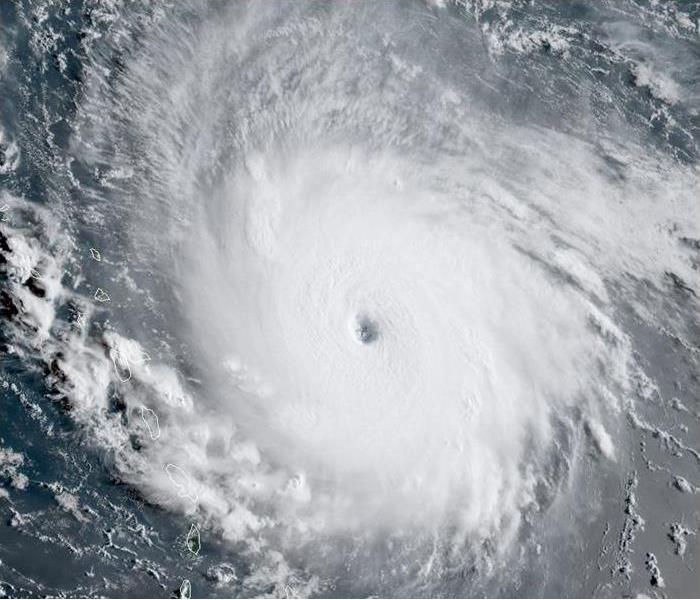 A little bit of information about hurricanes. It never hurts to know a little about the storms.
A little bit of information about hurricanes. It never hurts to know a little about the storms.
Hurricanes are some of the most violent storms on Earth....
Tropical cyclones are like giant engines that use warm, moist air as fuel. That is why they form only over warm ocean waters near the equator. The warm, moist air over the ocean rises upward from near the surface.
Air from surrounding areas with higher air pressure pushes in to the low pressure area. Then that "new" air becomes warm and moist and rises, too. As the warm air continues to rise, the surrounding air swirls in to take its place. As the warmed, moist air rises and cools off, the water in the air forms clouds. The whole system of clouds and wind spins and grows, fed by the ocean's heat and water evaporating from the surface.
Storms that form north of the equator spin counterclockwise. Storms south of the equator spin clockwise. This difference is because of Earth's rotation on its axis.
As the storm system rotates faster and faster, an eye forms in the center. It is very calm and clear in the eye, with very low air pressure. Higher pressure air from above flows down into the eye.
Storm Damage Prevention Tips
8/19/2020 (Permalink)
SERVPRO knows that storms are not set to a specific schedule, that’s why all SERVPRO franchises keep their doors open 24/7. We have the resources to handle any size disaster with a quicker response time than any of our competitors. Roof damage caused by thunderstorms is a major problem for homeowners, here are some tips to prevent roof damage to your home:
- Trim trees and remove dead branches so they won’t damage your home if they fall because of wind.
- Clear gutters and downspouts of debris. As the leaves fall, make sure they aren’t building up in the gutters.
- Check for any roof damage. Pay attention to surface bubbles and areas with missing gravel on flat roofs or missing or damaged shingles or tiles on sloped roofs.
- Check the flashing on the roof to make sure it’s in good condition to help prevent water from seeping through.
- If your roof needs replacing, consider impact-resistant roofing materials, especially if you live in an area where hail storms are common.
Call your local SERVPRO storm response team, in Texarkana, at 903-832-4400 for all your storm remediation needs!
When Lightning Strikes
7/24/2020 (Permalink)
Here at SERVPRO of Texarkana, we can help you with fire damages caused by lightning strikes. When the lightning hits a residence, it travels through the electrical lines to one of the home’s electrical boxes, which can catch fire. These fires can leave severe damage, including smoke damage to your home. SERVPRO of Texarkana's team has the ability to do a chem-sponge technique that was used to clean soot off of the walls. In doing this, SERVPRO of Texarkana can ensure that no fire damage or smoke damage goes untreated. If needed, affected walls in all damaged rooms can be painted after the cleanup is completed and drywall replaced where necessary. Our professional in-house crew use a white-glove treatment on your residence and completed the entire project quickly; from the first contact to completion. Why choose SERVPRO? Because in the event of fire damage or water damages large or small, we’re here to help. Call SERVPRO of Texarkana at (903) 832-4400 anytime lightning causes damage to your property.
What To Do When Storm Damage Occurs
5/11/2020 (Permalink)
We know what to do DURING a storm, but what do we do after the storm? Here are some helpful tips to get yourself back on track after a storm hits.
- You and your family’s safety is the number one goal. Watch out for safety hazards such as broken glass, and exposed nails. If dealing with flood waters be sure to wear protective clothing including boots, gloves, eye protection and masks as flood waters can carry sewage, bacteria, and other dangers. Stay away from downed powerlines. Be sure to use a flashlight instead of a candle when inspecting your home at night.
- When it’s safe to do so, document your damage. This will help when filing your insurance claim. Be sure to take photos and videos of your entire property – from multiple angles. Take photos of both the exterior and interior.
- If you have flooding, water extraction is the most important step to restoring your home. By choosing SERVPRO of Texarkana you can be sure that the water extraction will be handled quickly and professionally. Our professionals can evaluate your belongings to see if they can be cleaned and restored.
SERVPRO of Texarkana takes storm clean up seriously. We will make sure you are back on your feet in no time. Give us a call, 24/7 at 903.832.4400!
Protecting Your Windows During a Storm Event
2/27/2020 (Permalink)
Some homes in Texarkana, Texas may be especially susceptible to high winds. However, you don’t have to sacrifice style and comfort to prevent windblown glass and exposure to the elements. Examine the following shutter designs to choose the best one for your home.
1. Traditional Designs
When many people picture shutters, they imagine a wooden frame on either side of the window with rows of slats. This is called the colonial design, and it is so common that many homes use a non-functional version as a decorative window accent. However, depending on the conditions in your area, the colonial shutter variety might be a solid choice for storm protection as well. Another traditional design called the Bahama shutter has vertical hinges, allowing it to open into a small awning to provide shade in warmer climates.
2. Modern Equipment
Other homeowners choose a sleek and compact look to keep their shutters out of the way when no high winds are present. Accordion and rolling shutters are made of light metals or polycarbonate, giving them a high degree of strength and flexibility. This enables the window cover to fold away or roll up when not in use. These designs are typically more expensive than the traditional varieties, and can even be electrically-powered for added convenience.
3. Temporary Protection
Storm panels and plywood are another window damage prevention method for those in high-risk locations. These storm shutters are not intended for permanent installation, and properly speaking, they do not “shut” over the window at all. Storm panels are corrugated metal surfaces that are simply affixed to the window frame with screws. Plywood is an even cheaper solution and can be implemented faster, but may not be as secure.
Whatever shutter option you choose, remember that protecting your home against high winds is the first step toward avoiding interior flooding. Have the contact information of a qualified water damage restoration service ready if you anticipate severe weather conditions.
Storm Watch versus Warning
2/5/2020 (Permalink)
Storm Watch versus Warning
We hear these terms on TV and read about them online, but what really is the difference between a storm watch vs a storm warning?
Knowing what weather terms mean can help you prepare your home and family for any type of weather event. The best time to learn them is before any emergency happens.
FORECAST
A forecast tells you what meteorologists think is likely to happen. A forecast may tell you that storms are possible but not they’re not yet confirmed. The best action to take with a forecast is just to keep in mind and keep up with the news in case something stronger develops.
You can stay up to date with future weather forecasts by downloading many free weather apps on Android or iOS. Make sure you opt for free alerts on your phone or tablet.
Storm WATCH
We remember what a storm watch is by thinking, “We are watching to see if the storm comes towards us.”
A storm watch means conditions are favorable for severe weather, but will they actually happen? We don’t know, but the likelihood is yes more than no. Storms are either developing now or will develop.
Pay close attention to the weather forecast and be ready to take action. This is a great time to prepare your house if forecasts are calling for a strong storm.
- Tie down or bring in outdoor items that can go airborne.
- Clean out your gutters to prevent water from pooling on your roof.
- For serious storms, consider boarding up your windows.
- If a possible tornado is on its way, make sure your safe room is ready.
Storm WARNING
A storm warning means severe weather is occurring or is imminent in your area. It’s actually happening! Do not delay. Take action now to keep your family and pets safe.
Tornado Safety Tips
12/6/2019 (Permalink)
If you are at home
- If you have a cellar, storm shelter, safe room or basement available, go immediately to that area. If none of these options are available to you, get to the lowest level of your home.
- Get to a windowless interior room, such as a bathroom, closet or inner hallway
- Stay as far from windows as possible
- Go to the center of the room – corners tend to attract debris
- Get under a sturdy piece of furniture; heavy table or desk, and hold on to it
- Protect your head and neck with a blanket, if possible
If you are in a mobile home
Mobile homes are particularly vulnerable to tornadoes. They can be easily overturned, even if precautions have been taken to tie down the unit. If you are in a mobile home when a tornado is approaching, evacuate the home immediately.
- Take shelter in a building with a strong foundation
- If a shelter is not available, lie in a ditch or low-lying area a safe distance away from the mobile home.
- Use your arms to protect head and neck
If you are at work or school
- Go to the basement or an inside hallway at the lowest level
- Avoid places with wide-span roofs such as auditoriums, cafeterias, gymnasiums, large hallways or shopping malls
- Get under a sturdy piece of furniture such as a desk or heavy table.
- Use your arms to protect head and neck
If you are outdoors
- If possible, get inside a building.
- If shelter is unavailable or there is no time to get indoors, lie in a ditch or low-lying area or crouch near a strong building.
- Use your arms to protect your head and neck
- Stay alert to the potential for flooding
If you are in a vehicle
Never try to outrun a tornado. Tornadoes can change direction quickly and can instantly lift up a car, truck or any other vehicle and toss it through the air.
- Get out of the vehicle immediately and take shelter in a nearby building
- If there is no time to get indoors, get out of the vehicle and lie in a ditch or low-lying area away from the vehicle
- Use your arms to protect your head and neck
- Stay alert to the potential for flooding
Hail Damage
11/28/2019 (Permalink)
Hail can happen anywhere, but some parts of the U.S. see it more often than others. States in the Midwest are most susceptible. These storms are most common between May and September. Hail pellets are usually between .2 inches and 1.75 inches in size, but can be much bigger. In fact, the biggest known hailstone came in at 7.9 inches in South Dakota in 2010.
Hail damage isn’t always visible. When it is, you can look for cracked shingles, dents in shingles in a random pattern, and bent roof vents and pipes. You can also sustain damage to siding. Invisible damage comes into play when substrate materials beneath the shingles are damaged. If you think you have hail damage, we highly recommend getting an expert opinion. This kind of damage can lead to serious roof leaks that can spread and cause structural problems.
Be Storm Ready
9/11/2019 (Permalink)
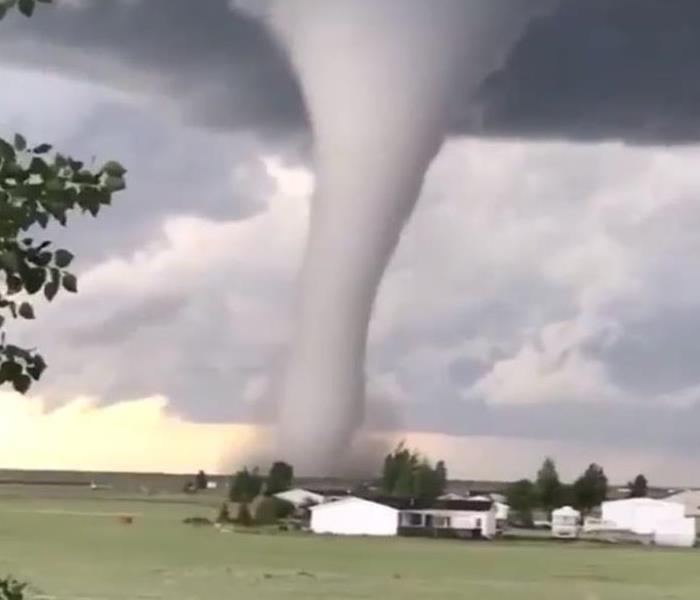 Any time you are under a tornado warning or watch you should always take the right precautions. A tornado will destroy anything in its path.
Any time you are under a tornado warning or watch you should always take the right precautions. A tornado will destroy anything in its path.
A major storm threat to houses comes from trees falling on them. Prune or thin the canopy of trees that are close to your house, so that wind can pass more easily through the branches without knocking them over. Remove branches facing your house to reduce weight on that side, since the tree is more likely to fall in the direction with more weight.
Identify top-heavy and tall furniture that are at risk of falling over, such as cabinets and bookcases. Secure them to the wall using L brackets, corner brackets, or aluminum molding. Secure or be ready to secure large appliances with flexible cable, braided wire, or metal strapping.
Prepare to board up your windows. All exterior windows and doors need to be secured no matter which side of the house they’re on, as tornadoes can approach from any direction. Boarding up your windows by attaching plywood, steel, or aluminum to the exterior wall may provide minimal protection in heavy winds, as the board can be torn away by winds getting under it. Duct tape and masking tape will also not prevent windows from breaking. If properly installed, specially developed screens and fabrics may help protect windows.
The 3 D's of Flood Clean-up
8/14/2019 (Permalink)
What are the cleaning requirements after a flood? You hear that flood water is contaminated, full of pathogens that are harmful to your family. How do you know what you need to throw away and what you can sanitize? Remember the three D’s of flood cleanup: Dispose, Disinfect and Dry. Here is a brief guide for each.
Dispose
Follow local guidelines for waste disposal. If garbage service is not yet running, you can bury contaminated food about four feet deep to keep the odor away. You should however dispose of the following items:
- Throw away any food, even canned or sealed, that has been in contact with flood water
- Throw away food from your fridge if power has been off for more than 2 hours
- Don’t use any garden produce that remain after a flood
- Discard dishes with cracks, as well as any plastic or wooden kitchen items
- Submerged drywall may need to be replaced
- Dispose of carpet padding
Disinfect
Depending on what materials need to be cleaned, the cleaning requirements will vary. For most disinfecting, use one cup of bleach to one gallon of water.
- Use bleach mixture and spray structural materials and personal items that were contaminated, rinse with clean water and dry
- Disinfect kitchenware and appliances by using hot soapy water, scrubbing to remove solids, then rinsing with disinfected water. Make sure appliances are unplugged before taking them apart and wiping them down. Allow them to dry completely before reassembling
Dry
Without a proper drying technique, your flood disinfectant effort isn’t complete.
Flood remediation professionals have powerful equipment to help accelerate the drying process and ensure that it is thorough. You should start the drying process right away to help prevent permanent damage or the development of mold.
- If power is back on, turn on fans and air conditioner unit to assist with drying until help arrives.
- Hang rugs and remove cushions to put them in a better area for drying
- Remove carpet and dry outdoors after cleaning
Trained restoration professionals can recognize what can be saved and what must be disposed of. They are trained in the proper cleaning requirements for specific materials.
Call SERVPRO of Texarkana, 24/7 for all your cleanup and restoration needs.
903-832-4400
Thunderstorm Preparedness
8/1/2019 (Permalink)
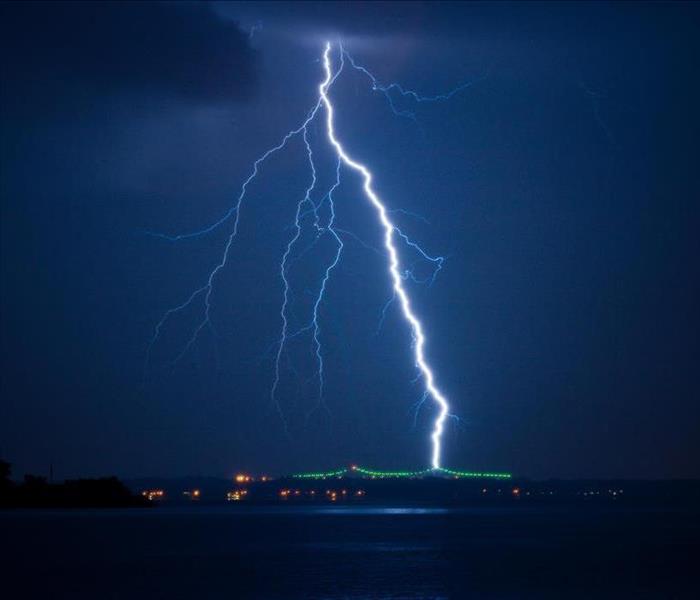 Take precautions during thunderstorms
Take precautions during thunderstorms
All thunderstorms are dangerous and produce lightning. On average lightning kills 51 people and injures hundreds more in the US each year. Dangers associated with thunderstorms include strong winds, flash flooding, hail, and even tornadoes.
To prepare for a thunderstorm:
- Trim or remove tree limbs near your home. Remove any dead or rotting trees.
- Secure outdoor items.
- Postpone or cancel outdoor activities.
- Go inside - if you can't reach a building, get in a hard-top vehicle.
- Secure doors and windows. Close blinds, curtains, or shutters.
- Unplug electronics.
When a thunderstorm occurs:
- Remember this phrase: "When Thunder Roars, Go Indoors". Go inside during thunderstorms.
- Listen to a battery-operated radio such as a NOAA Weather Radio for updates and information.
- Unplug electronics and appliances to prevent damage from lightning-caused power surges.
- Water conducts electricity. Water-based activities and chores should be avoided during a thunderstorm.
- Windows, porches, and doorways can be dangerous in storms - stay inside.
- If you can't get inside, try to avoid natural lightning rods - like a large tree in an open field, and try not to be the tallest thing on a hill, open field, or beach.
- Try not to touch metal - including your car - metal conducts electricity.
- Stay in your car if you're driving. Pull over and turn on your hazard lights until heavy rain ends.
After the storm passes:
- Never drive through a flooded roadway. Turn around, don't drown!
- Stay away from storm-damaged areas.
- Listen to a NOAA Weather Radio or local radio and television stations for updated information or instructions.
- Help people who may require special assistance, such as infants, children and the elderly or those with access or functional needs.
- Stay away from downed power lines and report them immediately.
- Keep a close eye on your pets to keep them safe.
The professionals at SERVPRO of Texarkana are highly trained and certified. From initial and ongoing training at SERVPRO's Corporate Training Facility to regular IICRC industry certifications, our Professionals are equipped with the knowledge they need to help with any water or fire loss.
SERVPRO of Texarkana 903-832-4400
What Kind of Damage Can you Expect From a Hailstorm
7/4/2019 (Permalink)
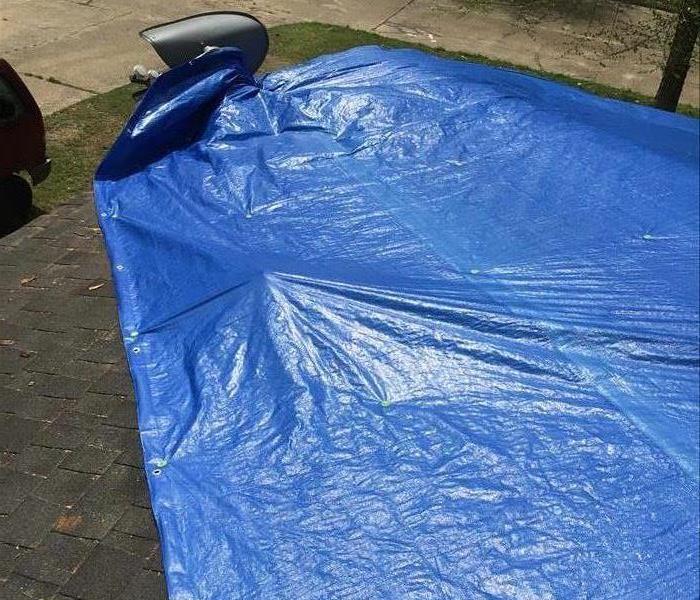 Roof damage caused by recent storms
Roof damage caused by recent storms
There’s no doubt that hail storms in Northeast Texas can lead to roof damage. Even the smallest hailstones can cause problems with enough force, especially on older commercial roofing. The extent of the damage can depend on the type of roof, the size of the hailstones, even wind speed. Learn about the three types of hail damage you can come to expect.
1. Exterior Damage
In a hailstorm, your business’s rooftops will always take the brunt of the damage. Shingles can end up cracked or missing, while other types of roofing can take major impact damage that leads to cracking, splitting, peeling and more. Some damage may be purely cosmetic, unsightly but not overly problematic. Other roof damage may cause functional issues that lead to the next type of damage – interior damage.
2. Interior Damage
Interior damage from hail storms occurs when the roof is cracked enough for water leaks to occur. When the roof is no longer watertight, you can end up with rain and melted hail or snow seeping into your building’s interior. Long before you notice dripping and dark spots on the floors, you could end up with water damage in your building’s attic, wet insulation, and rot in your structural framework.
3. Peripheral Damage
The last type of damage you can expect other than roof damage and interior damage is peripheral damage. While your roof may take the brunt of the storm, any equipment installed on your roof or around your building may also suffer impact damage. This can include satellite dishes, antennae, and exterior housings for HVAC or other building systems.
Prepare in Advance
The best offense is a good defense, and one of the best ways to avoid hail damage is to prepare in advance. Preparing can include repairing or upgrading roofing, or working with professionals to “toughen” your building’s resiliency to hail storms and impact. Don’t wait until the damage is already done; take precautions in advance.
If your property suffers hail damage, call SERVPRO of Texarkana (903)832-4400, we can make it "Like if never even happened."
Be Storm Ready
6/25/2019 (Permalink)
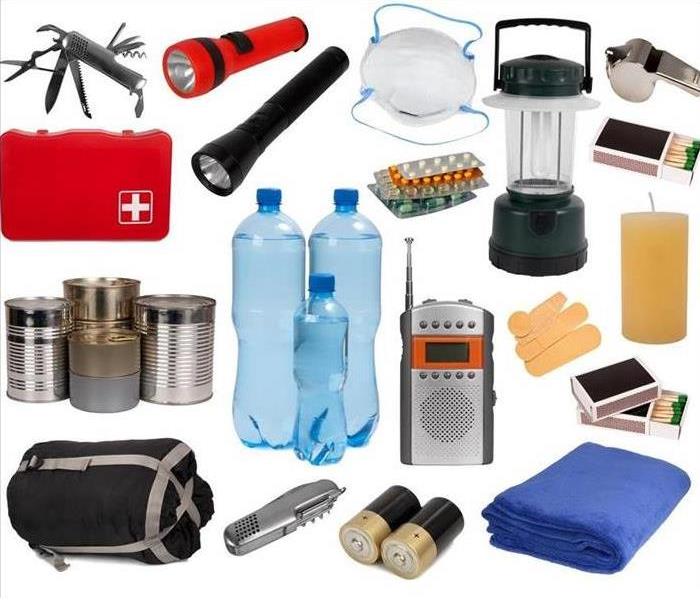 Common emergency kit items
Common emergency kit items
Severe weather can happen anytime, anywhere. In North East Texas we are particularly prone to experiencing severe weather throughout every season.
Approximately 98% of all disasters declared emergent by the president are weather-related, leading to around 500 deaths per year and nearly $15 billion in damage. Preparing an emergency supply kit can help keep you and your family safe if you're ever caught in an severe storm situation.
Build an Emergency Supply Kit
- Water (1 gallon per person per day)
- Food (non-perishable 3-day supply)
- Manual can opener
- Battery operated radio, preferably a NOAA Weather Radio
- Flashlight and extra batteries
- First aid kit
- Whistle to signal for help
- Clothing
- Dust masks or bandanas
- Plastic sheeting, garbage bags and duct tape
- Wrench or pliers to turn off utilities
- Hygiene items
- Important documents; copies of insurance policies, identification and bank account information
- Cash
- Fire extinguisher
- Matches in a waterproof container
Contact SERVPRO of Texarkana at 903-832-4400 for more readiness tips and tools, including SERVPRO’s Emergency READY Profile (ERP). Having an ERP in place for your facility can help minimize business interruption in the event of a disaster.
Tornado Awareness
4/30/2019 (Permalink)
Since Northeast Texas is located in "Tornado Alley" - an area of North America prone to tornadoes includes the states of Texas, Oklahoma, Kansas, Nebraska, and South Dakota - many of us that live here are used to dealing with the threats that tornadoes provide, but is our knowledge really up to par?
We are currently in the middle of tornado season, mid-March through June (although tornadoes can occur at anytime of the year), check out these tips to see if you know everything you need to know about staying safe during a tornado.
At Home
- Go to a windowless interior room on the lowest level of your house
- Get away from the windows
- Go to the center of the room
- Get under a piece of sturdy furniture such as a workbench, heavy table or desk to hold on to
Outdoors
- Use arms to protect head and neck
- If possible get inside a building
- If shelter is not available or there is no time to get indoors, lie in a ditch or low-lying area or crouch near a sturdy building
In a Vehicle
- Never try to drive faster than a tornado in a car or truck
- Get out of the car immediately and take shelter in a nearby building
- If there is no time to get indoors, get out of the car and lie in a ditch or low-lying area away from the vehicle.
For more information check out this website
Spring Storm Strategy
4/23/2019 (Permalink)
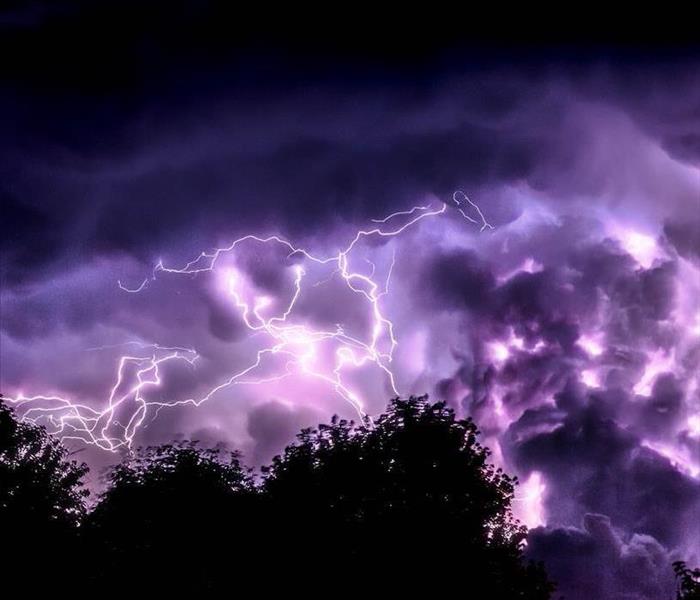 Be prepared for Spring Storms in the Ark-La-Tex area
Be prepared for Spring Storms in the Ark-La-Tex area
When preparing for an upcoming spring storm, protecting your home is your priority and something you take seriously. Here are a few ways to help you avoid storm damage to your residential property:
Let it flow. Remove winter's debris from your gutters, drains, and downspouts so that heavy rains can flow freely off your roof. Be sure that downspouts are secure and that water is draining well away from your home and not toward your foundation — add extensions if necessary.
Trim the trees. Prune lanky limbs and branches so they don't snap off in a windstorm and land on your home or a power line.
Check the pump. If your home has a sump pump, test it to make sure it's clean and operable and that the outflow is draining properly. Consider adding a battery-powered backup sump pump to keep the system working if the power goes out. Furthermore, an automatic standby generator can ensure your sump pump and other electrical systems continue to run during power outages.
Stow your gear. When strong winds are forecast, secure patio furniture and other yard items or put them in your garage or a shed so they don't become dangerous projectiles.
Cover up. Close and secure storm shutters if your home has them. Keep blinds and shades drawn and tape or tack window coverings around the edges to help protect you from broken, flying glass. Tie thick blankets over vehicles that are exposed to the elements to diminish damage from hail.
If power outages are common in your area, prepare an emergency kit and keep it in a central location in your home.
Basic supplies should include:
- Flashlight and fresh batteries
- Battery or solar-powered weather radio and/or transistor radio
- First aid supplies
- Hand sanitizer or wipes
- Three-day supply of canned or dried food and water
No one wants to deal with the headache of storm damage so call the team at SERVPRO of Texarkana 903-832-4400, we are available 24/7 to assess the damage and begin the mitigation process.
Hail Damage
4/2/2019 (Permalink)
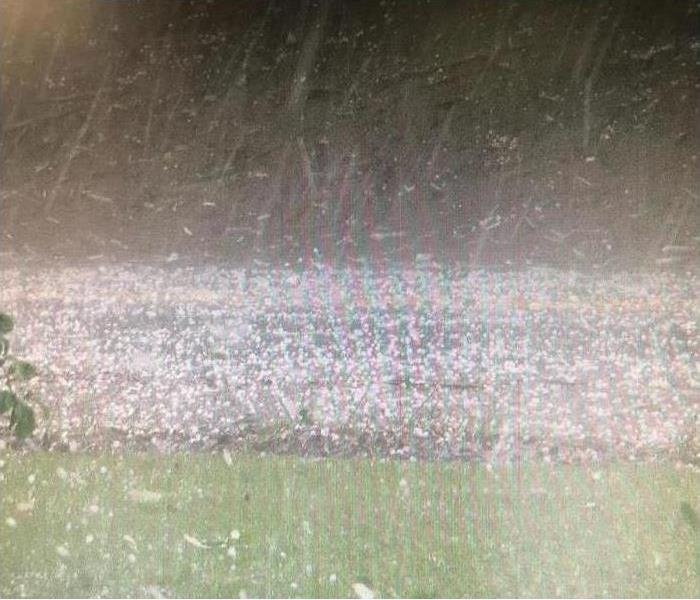 Hail can cause significant damage to your home
Hail can cause significant damage to your home
Hail is a common occurrence around Northeast Texas during storm season each year. Hail was the number one cause of homeowners insurance losses in Texas during the period from 1999-2011, at $10.4 billion. Knowing more about hail can help you be better prepared for the next time a storm hits - here are some interesting hail facts and tips:
- According to the National Oceanic and Atmospheric Association (NOAA) hail is responsible for over $1 billion dollars of property and crop damage each year.
- Hail can vary in size from pea-sized to pieces larger than grapefruits. While pea size hail is not particularly dangerous, it can cause roof damage over time that may eventually lead to a water damage.
- Hail comes from a specific type of thunderstorm cloud called a cumulonimbus.
- Hailstorms rarely last longer than 15 minutes, and typically last an average of 6 minutes.
- Meteorologists consider hail that has a diameter of 3/4 an inch or greater capable of causing significant damage to buildings and humans.
Call SERVPRO of Texarkana for all your mitigation and restoration needs.
Available 24/7 (903)832-4400
Storm Damage
3/6/2019 (Permalink)
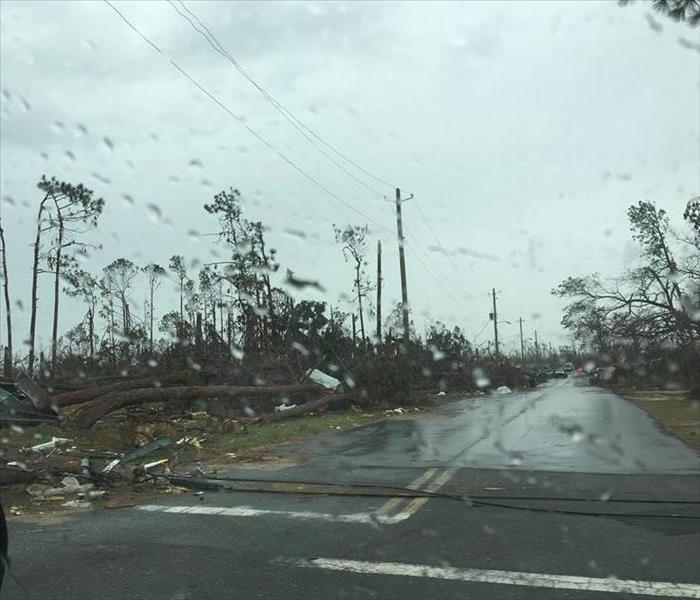 SERVPRO of Texarkana assisted in storm damage clean-up from Hurricane Michael
SERVPRO of Texarkana assisted in storm damage clean-up from Hurricane Michael
Floods and storms don’t wait for normal business hours, and neither do we. You can depend on an immediate response from our highly trained technicians, who are available 24/7 365 days. As a leader in storm and water damage restoration, SERVPRO of Texarkana has the specialized training and expertise to restore your home back to its pre-storm condition. Our restoration process puts an emphasis on scientific drying techniques, progress monitoring and documentation. We Have the Resources to Handle Storms and Disasters
Major storms and flooding events can overwhelm many restoration companies. On the other hand, SERVPRO of Texarkana can access resources from 1,700 Franchises across the state and country and even utilize Disaster Recovery Teams for major storms and disasters. SERVPRO of Texarkana is locally owned and operated, so we are part of this community too. When you have a flooding or storm emergency, we’re already nearby and ready to help. We take pride in being a part of the Texarkana community and want to do our part in making it the best it can be.
How to Prepare When a Storm Is in the Forecast
9/12/2018 (Permalink)
You should know well in advance when a storm is going to blow through Texarkana. While there is only so much you can do to prepare and protect your home, you should still take action to do everything possible to prevent flood water from entering your home and water damage from harming your property, because a completely flooded building is the last thing you need to deal with.
1. Learn How to Shut Off Electrical and Water Supply If you do not currently know where your circuit breaker and water main are located, then you need to find them on your property. You should turn off the power if your block experiences a power outage. You want to shut everything off because in the event power is restored, the sudden burst of energy could overload the system, resulting in significant damage to electrical appliances. You should also turn off all utilities right before you have to evacuate, if necessary.
2. Relocate Valuables Keep any precious heirlooms out of the basement, which is most susceptible to flood water. You also want to keep valuables away from doors and windows, because they are entry points by which water or winds can enter.
3. Trim Trees When you have several weeks’ notice of an oncoming storm in Texarkana, TX you should consider hiring a professional service to trim and prune trees that are too close to your home. A diseased tree or weakened branches can break off and strike a building.
4. Move Lawn Accessories Outside With strong enough winds, outdoor ornaments and furniture can become projectiles. Move them inside for the time being, or secure them outside by using a bungee cord or cable.
5. Maintain Gutters Your home’s gutters help keep flood water away from the siding and foundation of your house. Remove leaves and other debris from them regularly so water does not become impeded.
Call SERVPRO of Texarkana (903-832-4400) for more information on storm damage.
Steps To Take After Suffering Storm Damage
8/1/2018 (Permalink)
Storm damage can occur at any time and can cause an immense amount of harm to your home. Heavy rains can cause flooding and powerful winds can cause roof damage and downed trees on your property. Some post-storm damage can create safety and health hazards as well, so having a strategy to deal with damage will help you to be ready to take steps immediately after the storm.
Take Safety Precautions
Heavy winds and rain can create physical hazards such as collapsed roofing materials, window damage, collapsed walls or standing water in the basement or home interior. In addition, moisture can soak into furniture, carpeting, and building materials making the perfect environment for mold growth that can cause health issues. Shut off the main gas line if you smell gas. Beware of broken glass, exposed nails, and other sharp objects on the property. Contact SERVPRO of Texarkana to help do basic tasks to secure your property and make it safe to use. If necessary, arrange for an alternative place for you and your family to live while your property is being restored to a safe living condition.
Photograph the Damage
If it is safe to move around your property, use your cell phone or a camera to photograph the damage so that you will have a record for your insurance company. This action will ensure that you are fully compensated.
Contact Your Insurance Company
Contact your insurance agent to notify them about the damage to your home immediately. The company will send out an adjustor to determine the extent of the damage so that payment for repairs can be made.
SERVPRO of Texarkana 903-832-4400
Is It Going To Rain Today? Understanding the Weather Forecast
7/31/2018 (Permalink)
(Courtesy: National Weather Service/NOAA, Department of Commerce)
Since we do 24 hour emergency weather damage cleanup we definitely keep an eye on the weather. Each time it rains or storms we can get a wide range of phone calls from overflowing sump pumps to leaky windows and roofs, so it's important for us to follow and understand Weather Forecast Terminology. Here's some helpful information that should help you understand what all those weather terms mean.
Every day people check the weather forecast to plan their daily activities, but do they really understand what the meteorologist is telling them? This blog is intended to develop a better understanding of those forecasts. It is designed to help people make informed decisions about travel plans, sports practices and events, campouts or other outdoor activities before hazardous weather develops.
The National Weather Service (NWS) is the federal agency charged with providing weather services to the nation. It is the official source of watches, warnings and advisories for hazardous weather. Weather forecasts and warnings can be received directly from the NWS through its nationwide network of NOAA Weather Radio.
This blog will use terminology as defined by the NWS. Forecast products issues by countries other than the US have different criteria. Forecasters outside of the NWS (such as on radio and television) may use different terms or place a different meaning on weather terms.
Weather Forecast Terminology
The basic weather forecast includes the following weather elements: precipitation, probability of precipitation, sky condition, temperature and wind. Forecasts describe the weather in 12-hour increments such as "today", "tonight" and "tomorrow." Forecasters often use descriptive terms to convey the forecast message. While these terms may be subjective, the NWS attempts to standardize them.
Details on precipitation probabilities, sky conditions and wind will be provided in future blogs as well as information about additional Basic Weather Terms and Fire and Thunderstorm Related Terms.
Call SERVPRO of Texarkana 903-832-4400 for our storm services.
SERVPRO of Texarkana Arrives Quickly to Dry Out Your Flooded Property and Help Prevent Any Secondary Damages
7/27/2018 (Permalink)
Flood damage is perhaps one of the most overwhelming forms of property damage that you can find inside of your home. Debris carried by the storm waters can break a window and allow water to rush into your basement. You may have thought that you managed to weather the severe storm with little damage to your house, but upon checking your basement, you quickly realize that is not the case. Finding several inches of water inside of your home can leave you in an unfavorable position, but it is essential to call for professional help as soon as possible. The longer that you allow the water to remain in your home the worse the outcome can be. Waiting to try and compare all of your options is enough time to damage the carpet, the floor underneath, your belongings, and the structure of your residence. Mold spores are everywhere and relatively harmless in their primary form but, if they find a source of water, they may begin to grow into a mold colony. If you find water damage of any kind in your home, it is better to be safe rather than sorry. Our SERVPRO techs can arrive at the scene of the flood damage swiftly. We strive to get the water out of your home as soon as possible, so we use advanced technology designed to remove it quickly. SERVPRO technicians will bring tools like extractors, wet/dry vacuums and portable pumps to your property. Extractors not only pull the water away, but they also have a heating element that serves to help dry your furniture and carpets as we remove the water. Once we remove all of the floodwaters, SERVPRO can focus on detecting any excessive moisture and drying out the structure of your home using our state of the art drying equipment. Do not wait when you find flood waters in your home. Dial (903) 832-4400 to reach out to SERVPRO of Texarkana. Let us help you remove the water and return your basement to its preloss state.
TORNADO KNOWLEDGE
7/2/2018 (Permalink)
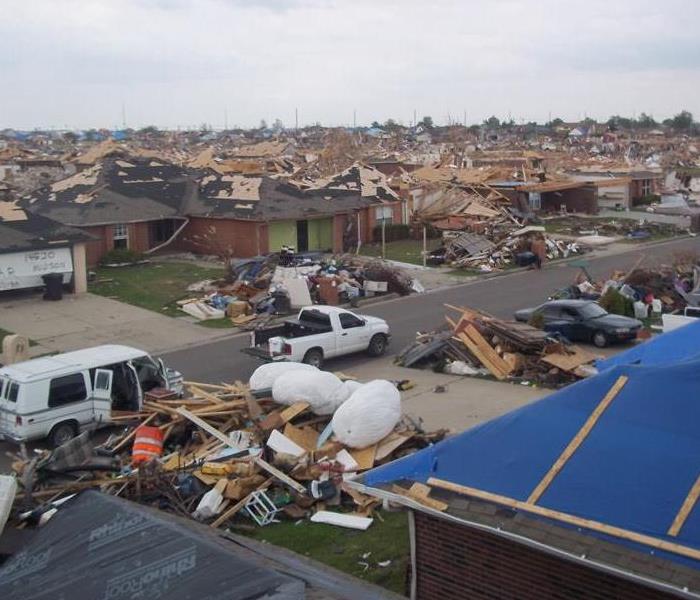 Destruction caused by Tornado in Moore, OK
Destruction caused by Tornado in Moore, OK
Since Northeast Texas is located in "Tornado Alley" - an area of North America prone to tornadoes includes the states of Texas, Oklahoma, Kansas, Nebraska, and South Dakota - many of us that live here are used to dealing with the threats that tornadoes provide, but is our knowledge really up to scratch?
Since we are currently in the middle of tornado season, mid-March through June (although tornadoes can occur at anytime of the year), check out these tips to see if you know everything you need to know about staying safe during a tornado.
- You should NOT open windows during a tornado. It is a common myth that it equalizes the pressure in your house; however, it does not do anything other than cause you to spend precious time outside of your shelter area. Doors should also not be opened, as it makes it easier for dangerous debris to fly into the house.
Always pick an interior room, on a ground floor, and without windows as a shelter. If it is an option try to be in a room close to the north or northwest side of your home as tornadoes
HAIL DAMAGE
6/28/2018 (Permalink)
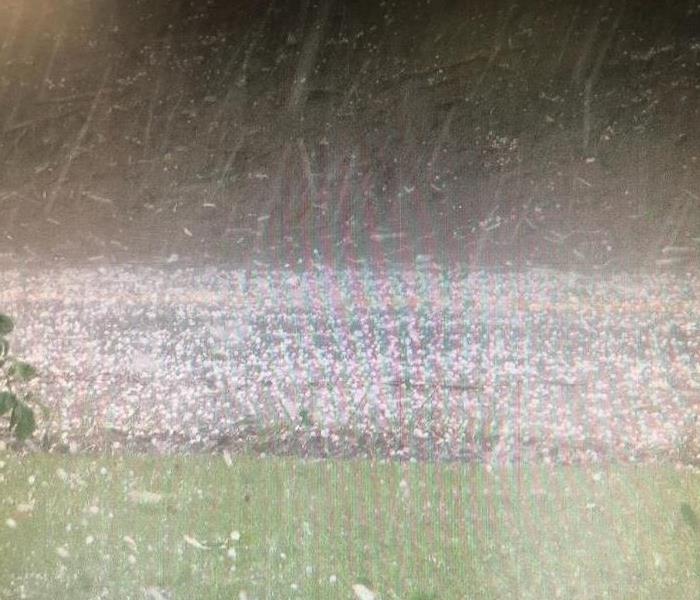 Hail can cause significant damage to your home's roof.
Hail can cause significant damage to your home's roof.
Hail is a common occurrence around Northeast Texas during storm season each year. Hail was the number one cause of homeowners insurance losses in Texas during the period from 1999-2011, at $10.4 billion. Knowing more about hail can help you be better prepared for the next time a storm hits - here are some interesting hail facts and tips:
- According to the National Oceanic and Atmospheric Association (NOAA) hail is responsible for over $1 billion dollars of property and crop damage each year.
- Hail can vary in size from pea-sized to pieces larger than grapefruits. While pea size hail is not particularly dangerous, it can cause roof damage over time that may eventually lead to a water damage.
- Hail comes from a specific type of thunderstorm cloud called a cumulonimbus.
- Hailstorms rarely last longer than 15 minutes, and typically last an average of 6 minutes.
- Meteorologists consider hail that has a diameter of 3/4 an inch or greater capable of causing significant damage to buildings and humans.
Emergency Supply Kit
6/22/2018 (Permalink)
Severe weather can happen anytime, anywhere. In North Texas we are particularly prone to experiencing severe weather throughout every season.
Approximately 98% of all disasters declared emergent by the president are weather-related, leading to around 500 deaths per year and nearly $15 billion in damage. Preparing an emergency supply kit can help keep you and your family safe if you're ever caught in an severe storm situation.
Build an Emergency Supply Kit
- Water (1 gallon per person per day)
- Food (non-perishable 3-day supply)
- Manual can opener
- Battery operated radio, preferably a NOAA Weather Radio
- Flashlight and extra batteries
- First aid kit
- Whistle to signal for help
- Clothing
- Dust masks or bandanas
- Plastic sheeting, garbage bags and duct tape
- Wrench or pliers to turn off utilities
- Hygiene items
- Important documents; copies of insurance policies, identification and bank account information
- Cash
- Fire extinguisher
- Matches in a waterproof container
Contact SERVPRO of Texarkana at 903-832-4400 for more readiness tips and tools, including SERVPRO’s Emergency READY Profile (ERP). Having an ERP in place for your facility can help minimize business interruption in the event of a disaster.
What a storm is.
2/15/2018 (Permalink)
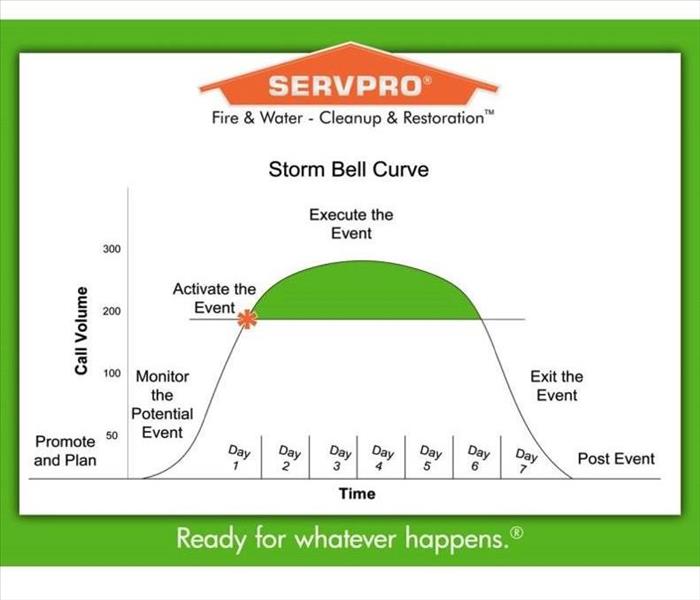 Storm Bell Curve
Storm Bell Curve
What Storm is:
A controlled response managed by one or more SERVPRO® Storm Sites which are operated by one of four Franchise owned teams. These Storm Sites are committed to being in a constant state of readiness. Always answering the call and mobilizing to service National Accounts clients’ customers. Always willing to assist the Local Franchises in servicing spikes in volume for which they have difficulty getting to all customers in a timely fashion.
What Storm is not:
Storm is not a severity initiative, so it is not LLRT or ERT response. However, commercial or large losses often occur in a Storm affected area. When they do the Storm Leaders work with CLLD and the LLRT or ERT Franchises to respond to opportunities and manage the work produced.
Storm Response is managed in six phases:
- Promote and Plan
- Monitor the Potential Event
- Activate the Event
- Execute the Event
- Exit the Event
- Post Event
When Storms or Floods hit Texarkana, SERVPRO is ready!
2/2/2017 (Permalink)
SERVPRO of Texarkana specializes in storm and flood damage restoration. Our crews are highly trained and we use specialized equipment to restore your property to its pre-storm condition.
Faster Response
Since we are locally owned and operated, we are able to respond quicker with the right resources, which is extremely important. A fast response lessens the damage, limits further damage, and reduces the restoration cost.
Resources to Handle Floods and Storms
When storms hit the Texarkana area, we can scale our resources to handle a large storm or flooding disaster. We can access equipment and personnel from a network of 1,650 Franchises across the country and elite Disaster Recovery Teams that are strategically located throughout the United States.
Have Storm or Flood Damage? Call Us Today 903-832-4400





 24/7 Emergency Service
24/7 Emergency Service


